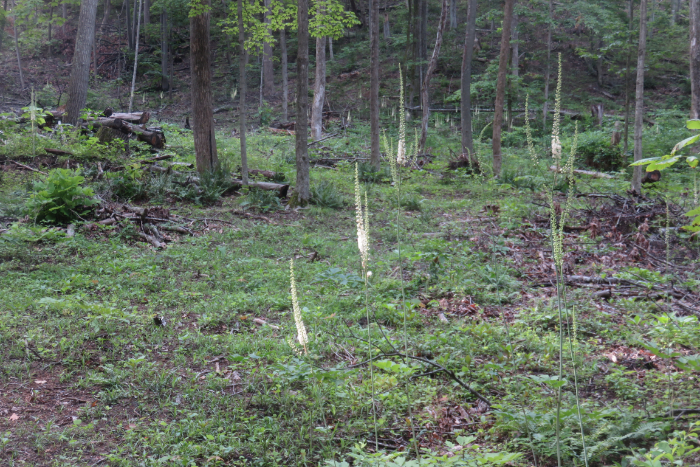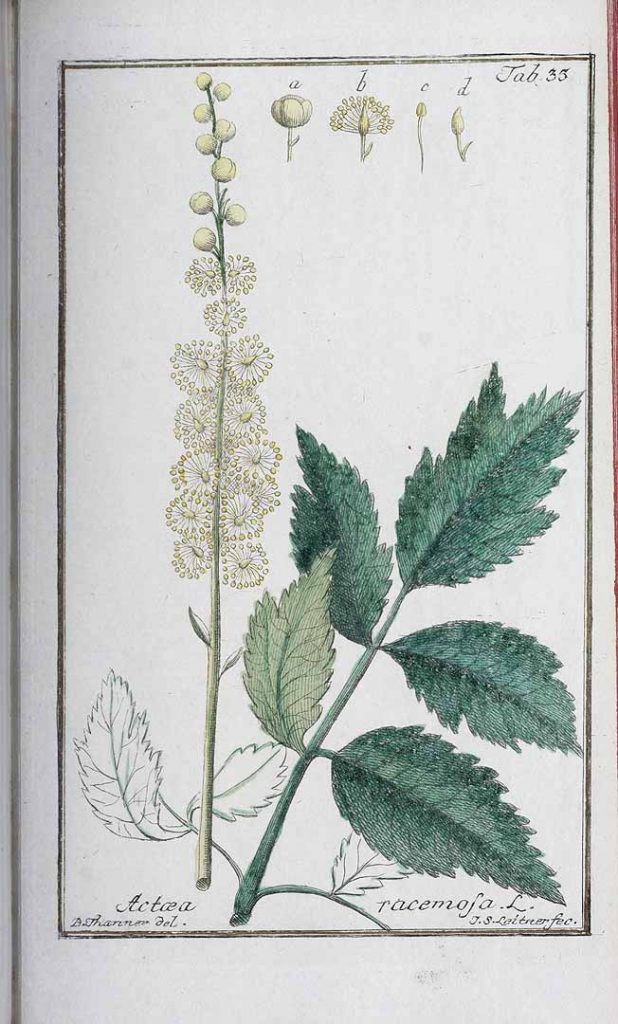
06.26.20 Forest Candelabra
 The forest is now dark, the light seeping through the thick overstory of many-layered leaves is fleeting. It appears only as an occasional tiny, sparkling presence which crawls across the woodland floor or creeps across trunks of towering trees. Woodland flowers have become rare, insect-dependent blossoms now appear in the meadows or forest edges filled with summer’s buzzing buglife. Walking through the quiet, thick shade and discovering a mysterious colony of giant fairy candles, Cimicifuga racemosa, reaching almost nine feet tall is like entering a secret ball room illuminated by these mysterious bright white infloresences. Each spike branches exactly like a candelabra into a set of three fragile tapers. This magnificent plant has received the ignominious common name of “bugbane”. This gruesome epithet is the result of the special relationship these flowers have with insects. Since the vast majority of flyers have moved to sunnier locations, this plant depends on lowly beetles and carrion flies for pollination. To this end it has developed a malodorous perfume which most describe as fetid. Quite interestingly this odor not only attracts these “lower order” insects it repels many of our flying, stinging friends from the fields. Early peoples, both indigenous and colonizing, would crush this plant and rub it on their exposed skin to keep the biting bugs away. Despite this efficacious value, I love these blossoms for their ethereal, albeit slightly creepy, presence.
The forest is now dark, the light seeping through the thick overstory of many-layered leaves is fleeting. It appears only as an occasional tiny, sparkling presence which crawls across the woodland floor or creeps across trunks of towering trees. Woodland flowers have become rare, insect-dependent blossoms now appear in the meadows or forest edges filled with summer’s buzzing buglife. Walking through the quiet, thick shade and discovering a mysterious colony of giant fairy candles, Cimicifuga racemosa, reaching almost nine feet tall is like entering a secret ball room illuminated by these mysterious bright white infloresences. Each spike branches exactly like a candelabra into a set of three fragile tapers. This magnificent plant has received the ignominious common name of “bugbane”. This gruesome epithet is the result of the special relationship these flowers have with insects. Since the vast majority of flyers have moved to sunnier locations, this plant depends on lowly beetles and carrion flies for pollination. To this end it has developed a malodorous perfume which most describe as fetid. Quite interestingly this odor not only attracts these “lower order” insects it repels many of our flying, stinging friends from the fields. Early peoples, both indigenous and colonizing, would crush this plant and rub it on their exposed skin to keep the biting bugs away. Despite this efficacious value, I love these blossoms for their ethereal, albeit slightly creepy, presence.
 Illustration from J. Zorn’s Icones plantarum medicinalium, 1779-1784.
Illustration from J. Zorn’s Icones plantarum medicinalium, 1779-1784.
 Josef Beery
Josef Beery The forest is now dark, the light seeping through the thick overstory of many-layered leaves is fleeting. It appears only as an occasional tiny, sparkling presence which crawls across the woodland floor or creeps across trunks of towering trees. Woodland flowers have become rare, insect-dependent blossoms now appear in the meadows or forest edges filled with summer’s buzzing buglife. Walking through the quiet, thick shade and discovering a mysterious colony of giant fairy candles, Cimicifuga racemosa, reaching almost nine feet tall is like entering a secret ball room illuminated by these mysterious bright white infloresences. Each spike branches exactly like a candelabra into a set of three fragile tapers. This magnificent plant has received the ignominious common name of “bugbane”. This gruesome epithet is the result of the special relationship these flowers have with insects. Since the vast majority of flyers have moved to sunnier locations, this plant depends on lowly beetles and carrion flies for pollination. To this end it has developed a malodorous perfume which most describe as fetid. Quite interestingly this odor not only attracts these “lower order” insects it repels many of our flying, stinging friends from the fields. Early peoples, both indigenous and colonizing, would crush this plant and rub it on their exposed skin to keep the biting bugs away. Despite this efficacious value, I love these blossoms for their ethereal, albeit slightly creepy, presence.
The forest is now dark, the light seeping through the thick overstory of many-layered leaves is fleeting. It appears only as an occasional tiny, sparkling presence which crawls across the woodland floor or creeps across trunks of towering trees. Woodland flowers have become rare, insect-dependent blossoms now appear in the meadows or forest edges filled with summer’s buzzing buglife. Walking through the quiet, thick shade and discovering a mysterious colony of giant fairy candles, Cimicifuga racemosa, reaching almost nine feet tall is like entering a secret ball room illuminated by these mysterious bright white infloresences. Each spike branches exactly like a candelabra into a set of three fragile tapers. This magnificent plant has received the ignominious common name of “bugbane”. This gruesome epithet is the result of the special relationship these flowers have with insects. Since the vast majority of flyers have moved to sunnier locations, this plant depends on lowly beetles and carrion flies for pollination. To this end it has developed a malodorous perfume which most describe as fetid. Quite interestingly this odor not only attracts these “lower order” insects it repels many of our flying, stinging friends from the fields. Early peoples, both indigenous and colonizing, would crush this plant and rub it on their exposed skin to keep the biting bugs away. Despite this efficacious value, I love these blossoms for their ethereal, albeit slightly creepy, presence. Illustration from J. Zorn’s Icones plantarum medicinalium, 1779-1784.
Illustration from J. Zorn’s Icones plantarum medicinalium, 1779-1784.